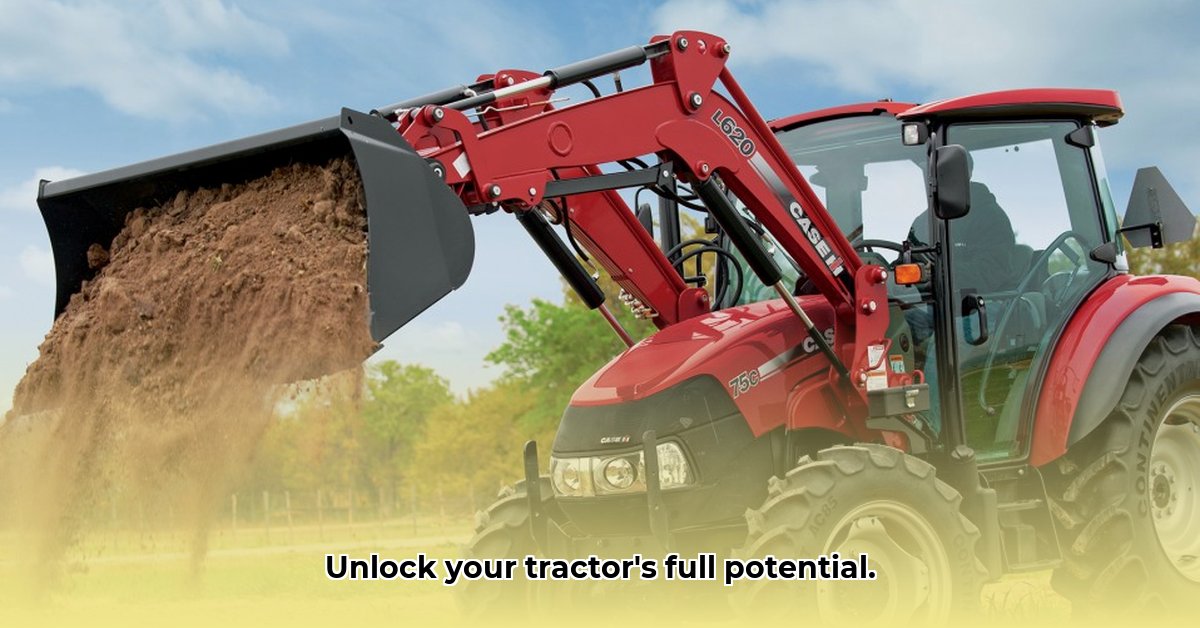
Loader Attachment for Tractor: Your Ultimate Guide to Choosing and Using Them
Ready to supercharge your tractor's capabilities? Selecting the right loader attachments is crucial for boosting efficiency and tackling a wider range of tasks. This guide will walk you through choosing attachments that perfectly fit your tractor, ensuring smooth operations and avoiding frustrating struggles. Whether you're clearing snow, moving materials, or tackling landscaping, we'll help you find the perfect tools for the job. For more information on tractor implements, check out this helpful resource on tractor tillers.
Understanding Your Tractor's Needs and Your Own
Before browsing catalogs, consider your typical workload. Will you be moving hay bales daily, or completing occasional projects? A farmer hauling heavy loads needs a different attachment than someone occasionally moving gravel. Knowing your needs dictates the type and capacity of the attachment required. Don't underestimate this crucial first step – it's the foundation of your decision-making process. What are your most frequent tasks? This will heavily influence your choice of attachment.
The Amazing World of Tractor Loader Attachments: A Look at Your Options
A wide variety of attachments exists, each designed for specific tasks. Let's explore the most popular:
Buckets: Versatile for moving materials, digging, and leveling. Sizes and designs vary, from small buckets ideal for gravel to large ones for moving dirt and snow. Consider the material's weight and type; a bucket designed for rocks might not be suitable for delicate landscaping.
Forks: Effortlessly move palletized goods, hay bales, and other neatly stacked materials. Single and double forks are available, with double forks handling heavier loads. Many newer models offer third-function hydraulics for added versatility. Do you frequently handle palletized materials? Forks will significantly increase efficiency.
Grapples: Ideal for handling messy, awkward, or unusually shaped materials like brush, logs, or scrap metal. Their claws provide a secure grip, simplifying handling of irregular items. Are you involved in forestry or cleanup operations? Grapples provide a significant advantage.
Snow Blades: In snowy climates, a snow blade is invaluable for clearing driveways, roads, and fields. Choosing the right size is critical; too small a blade will struggle, while one that's too large can overwork your tractor. Do you require snow removal capabilities? Investing in a snow blade is worth exploring.
Specialized Attachments: Beyond these common types, many other specialized attachments are available, including root rakes, rock buckets, bale spears, and more. Each caters to specific tasks, expanding your tractor's versatility.
Making Sure It Fits: Attachment and Tractor Compatibility
Before purchasing, consult your tractor's owner's manual. This is essential for ensuring compatibility with your tractor's hydraulic system and lifting capacity. The manual specifies the maximum weight your tractor can lift and the hydraulic flow rate. Ignoring these limits risks damaging your tractor, the attachment, or causing injury. Ensure the attachment's mounting system matches your tractor's loader; quick-attach systems simplify swapping attachments. Is your tractor equipped for quick-attach systems? This significantly enhances operational efficiency.
Installation: A Step-by-Step Guide to Safe Attachment Mounting
Safety is paramount. Follow these steps:
- Consult manuals: Carefully read both your tractor and attachment manuals.
- Secure your tractor: Engage the parking brake firmly.
- Use proper lifting tools: Use a hoist or other equipment if needed to lift the attachment. Avoid attempting this alone if the attachment is heavy.
- Precise alignment: Align pins and mounting points before securing them.
- Double-check: Verify all connections are secure.
- Test carefully: Test lifting and lowering mechanisms before starting any work.
Keeping Your Attachment in Top Shape: Maintenance and Troubleshooting
Regular maintenance extends equipment lifespan. Check hydraulic fluid levels, address leaks immediately, lubricate moving parts, and regularly clean debris.
Common Issues and Solutions:
| Problem | Solution |
|---|---|
| Hydraulic leaks | Inspect hoses and fittings; replace damaged parts. |
| Attachment malfunctions | Check hydraulic connections and component function. |
| Pin or bolt failure | Replace broken parts immediately. |
| Issues with lifting arm | Check for restrictions or damage; inspect hydraulic pressure and system. |
Making the Right Choice: A Final Word on Selecting Your Perfect Attachment
Choosing the right loader attachment involves considering your needs, tractor capabilities, and safety. This investment boosts efficiency and productivity. Remember, thorough research and informed decisions prevent costly mistakes.
How to Choose the Best Tractor Loader Attachment for My Specific Needs
Key Takeaways:
- Matching attachments to your tractor's capabilities (hydraulic capacity, horsepower) is crucial for safe and efficient operation.
- Consider long-term value; better quality typically translates to longevity and reduced replacement costs.
- Specialized tools often outperform versatile options for specific tasks; choosing the right tool for the job maximizes efficiency.
Understanding Your Needs: Types of Tractor Loader Attachments
We've already covered this – but a reminder is helpful. Choose the right attachment for your job.
Step-by-Step Guide to Selecting the Right Attachment
- Assess Your Tasks: Identify your most frequent tasks (e.g., moving feed, clearing snow, handling hay).
- Check Tractor Specs: Verify lift capacity and hydraulic flow rate.
- Size and Weight: Consider material size and weight.
- Durability and Cost: Prioritize quality for longevity.
- Compatibility: Ensure attachment compatibility with your tractor's loader.
- Reviews and Recommendations: Gather feedback from others.
- Try Before You Buy (if possible): Test the attachment before committing to a purchase.